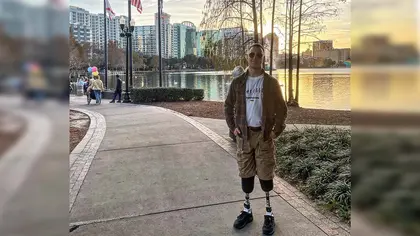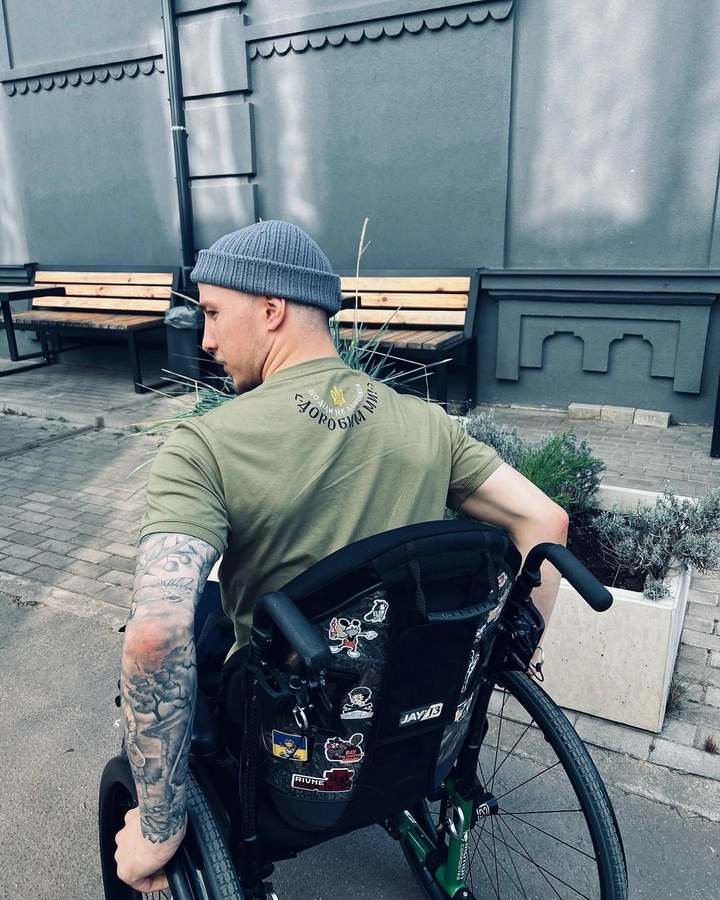“I noticed that people were looking away when they saw me,” says Oleksandr, “My amputation made them uncomfortable, and they didn’t know how to react. So, they pretended not to see it.”
Oleksandr Budko is a Ukrainian veteran. At the age of 26, he volunteered to serve in Ukraine’s Armed Forces as Russia unveiled its full-scale invasion against his home country.
JOIN US ON TELEGRAM
Follow our coverage of the war on the @Kyivpost_official.
Within six months, he transitioned from a city barista into a unit commander, fighting on the Russian-Ukrainian border. In summer 2022, Oleksandr and his comrades were stationed near Kharkiv, Ukraine’s second-largest city, preparing to free those parts of the region that were under Russian occupation.
On Aug. 24, Ukraine’s Independence Day, Oleksandr’s unit was attacked. He was resting in the trench at that time, didn’t hear the missile that hit them – but he immediately felt the sharp pain in his body.
On that day, he lost both his legs – and would have to adjust to a difficult transition from a fit, healthy and an active serviceman to an amputee.
“I cried when I told my parents what happened to me,” Oleksandr recalls, “When I got into the wheelchair, it hit me: I had to start a new life.”
Oleksandr is among nearly three million of Ukrainians with a disability a number that is likely to grow as a result of the ongoing Russian war. He has experienced firsthand the hardships disabled individuals have to live through because of Ukraine’s lack of accessible infrastructure, and the resources to cater to people with special needs.

Zelensky Meets CIA Director William Burns in Ukraine
Now, however the need to address inclusivity during Ukraine’s reconstruction is already being addressed – with people like Oleksandr shaping up the agenda and advocating for greater representation. While the country’s rebuilding will take time, millions of disabled Ukrainians will have to try to overcome the everyday struggles of inaccessibility and constant dangers posed by the Russian war.
Marginalizing disabilities
Oleksandr remembers seeing his wound for the first time after the attack. He opened his eyes after the blast, and he saw that he still had his legs – but they didn’t work anymore. He felt excruciating pain.
“My legs were just a mush of bones, meat, and some clothes on top,” he recalls, “All the muscle tissue was torn off, the bones were crushed, and only the toes and tendons remained.”
Oleksandr’s comrades rescued him from the trench – and from there, delivered him to a hospital away from the frontline. He spent weeks waiting for surgery and fearing his legs would begin to rot – when finally, they were both amputated.
“After my surgery, I got an infection, so I had to undergo a second amputation,” the man says. “I ate very little in-between surgeries, so later on, I started getting back into shape, trying to move, and working on my sleep – because I barely slept before.”
Two months after the surgery, Oleksandr got his first prosthetics – and begun learning how to walk with them. It was very hard at first – but using the wheelchair was just as hard. This was when Oleksandr realized how inaccessible most of Ukraine was – as there was little infrastructure access for a wheelchair.
“At some point, I understood that my life would never be the same again. When I returned home in a wheelchair, it devastated me that I could not move freely in my own house because it was in no way adapted for a person with a disability. I could not travel freely around the city because the sidewalks were not accessible, too, and this inaccessibility was everywhere.”
Oleksandr noticed a lot of staring in addition to the difficulties he faced in moving around. Although in Ukraine the law guarantees that all veterans receive free prosthetics, the state is currently incapable of keeping up with the demand. Oleksandr applied for help to one of the international funded organizations and was able to get his prosthetics in the US.
“It took about a month for my legs to adapt to my new prosthetics,” he recalls. “I had one goal: to get back on my feet as soon as possible, so I spent a month in constant training despite the pain and fatigue. I mastered my walking prosthetics, but unfortunately, I am still struggling with the ones used for running – and continually fall off them.”
Oleksandr is vocal about his struggles as a veteran-amputee, and he hopes his experience will raise awareness of the everyday struggles related to accessibility.
“I don’t want Ukrainians approach me on the street telling me that they are sorry for me,” he says. “Rather, I want wounded soldiers and disabled individuals feel like they have a place in this society.”
More struggles ahead
“People with disabilities experience the Russian war in diverse ways,” says Hanna Zaremba, a researcher at the Department of Social Anthropology at the Ethnology Institute of Ukraine. “There are rescuers and those getting rescued, victims and activists, and the roles are blending. Many people with disabilities also serve as soldiers – even some Para-Olympic athletes join the army.”
Hanna is also a civil society activist for the rights of people with disabilities in Ukraine who studies and collects testimonies from disabled Ukrainians.
“I was involved in the evacuation of people with disabilities and looking for accessible shelters for them in Western Ukraine,” she says. “In the early days of the invasion, we had cases of people stuck in their apartments – for example, the elevators in their apartment buildings were turned off, and they needed their neighbors to take them out from their apartments and carry them out physically.
“Municipalities and regional administrations were supposed to evacuate people with disabilities in an organized manner, but of course, when the full-scale invasion started, these institutions were not ready to respond quickly to the needs [of those] with disabilities, especially those who lived in closed institutions,” the expert adds. “So, evacuations of people with disabilities became an individual responsibility and a personal problem.”
As Hanna points out, people with disabilities are rarely represented when we talk about the war; yet they are active participants engaged in evacuations, activists, and community leaders. Various civil society organizations that care for people with intellectual disabilities started doing volunteering work such as making camouflage nets, candles, and fundraising.
“Yet, there are lots of people with disabilities who are on their own in this war,” Hanna says. “I met a person with intellectual disabilities who needed assistance and didn’t know where to find information or legal advice. He was all by himself. He managed to flee the occupied territories into Ukraine-controlled areas, but he did not have anyone accompany him.
“So, the full-scale invasion showed many institutional issues in Ukraine such as inability to evacuate people from closed institutions or provide them with the needed services and aid.”
In addition, none of the residential shelters in Ukraine are accessible to disabled people, especially for wheelchair users. There are even cases where people in wheelchairs were refused access. Other issue surround providing people with disabilities with the psychological and legal support they need – for example, there are virtually no psychologists trained in sign language in Ukraine.
“For now, helping people with disabilities was shouldered by civil society and community networks,” Hanna concludes. “Grassroots organizations are trying to fill in the gap that should be covered by the state, but we need to move to the human-rights model when it comes to disability. This means that human rights and inclusion have to be at the forefront of Ukraine’s reconstruction.”
You can also highlight the text and press Ctrl + Enter







